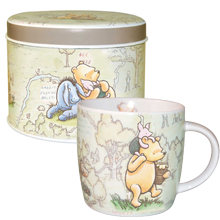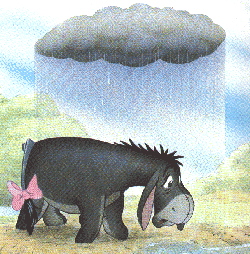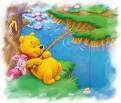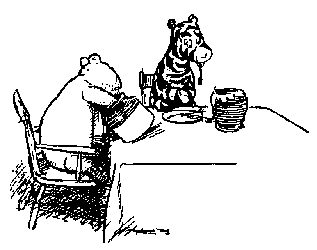
|

Seligor's Castle, fun for all the children of the world.
Blogs
Thu, 20 May 2010
|
 Another Gem from the wonderful but strange A.A. Milne. Another Gem from the wonderful but strange A.A. Milne.
 Seligor's Castle
presents Seligor's Castle
presents
SPRING MORNING
BY THE
WONDERFUL
A. A. MILNE. Where am I
going? I don't quite know.
Down to the stream where the king-cups grow --
Up on the hill where the pine-trees blow --
Anywhere, anywhere. I don't know.
Where am I going?
The clouds sail by,
Little ones, baby ones, over the sky.
Where am I going? The shadows pass,
Little ones, baby ones, over the grass.
 If you were a cloud, and sailed up
there, If you were a cloud, and sailed up
there,
You'd sail on water as blue as air,
And you'd see me here in the fields and say:
"Doesn't the sky look green today?"
Where am I going?
The high rooks call:
"It's awful fun to be born at all."
Where am I going? The ring-doves coo:
"We do have beautiful things to do."
If you were a
bird, and lived on high,
You'd lean on the wind
when the wind came by,
You'd say to the wind when it took you away:
"That's where I wanted to go today!"
Where am I going?
I don't quite know.
What does it matter where people go?
Down to the wood where the blue-bells grow --
Anywhere, anywhere. I don't
know. 
This little poem comes from one of
my most precious books with the title
When We Were Very Young It was published in 1921 and the
decorations are by Ernest H.
Shepard Alan Alexander Milne has written a
small forward to the book himself and I really
would like to tell you what it says, so here it is
just for you At one time (but I have
changed my mind now) I
thought I was going to write a little Note at the
top of each of these poems, in the manner of Mr.
William Wordsworth, who liked to tell his readers
where he was staying, and which of his friends he
was walking with, and what he was thinking about,
when the idea of writing his poem came to
him.
You will find some lines about a swan here,
if you get as far as that, and I should have
explained to you in that Note that Christopher
Robin, who feeds this swan in the mornings, has
given him the name of "Pooh." This is a very
fine name for a swan, because if you call him and
he doesn't come (which is a thing swans are good
at), then you can pretend that you were just saying
"Pooh! " to show how little you wanted him. Well, I
should have told you that there are six cows who
come down to Pooh's lake every afternoon to drink,
and of course they say "Moo " as they come. So I
thought to myself one one fine day, walking with my
friend Christopher Robin, "Moo rhymes with Pooh !"
Surely there is a bit of poetry to be got out of
that?"
Well then I begin to think about this
ship on the swan on his lake; and at first I
thought how lucky it was that that his name
was Pooh; and then I didn't think about that any
more . . . and the poem came quite
differently from what I had intended.
. . . and all I can say for
it now is that, if it hadn't been for Christopher
Robin, I shouldn't have written it ; which indeed,
is all I can say for any of the others.
So this
is why these verses go about together, because they
are all friends of Christopher Robin; and if I left
out one because it was not quite like the one
before, then I should have to leave out the one
before because it was not quite like the next,
which would be disappointing for them.
Then
there is another thing. You may wonder
sometimes who is supposed to be saying the verses.
Is it the Author, that strange but uninteresting
person, or is it Christopher Robin, or some other
boy or girl, or Nurse, or Hoo? If I'd have followed
Mr. Wordsworth's plan, I could have explained this
each time; but, as it is, you will have to decide
for yourselves. If you are not quite sure, then it
is probably Hoo. I don't know if you have ever met
Hoo, but he is one of those curious children who
look four on Monday, and eight on Tuesday, and are
really twenty eight on Saturday; and you never
know whether it is the day that he can
pronounce his " r's "
He had a great deal
to do with these verses. In fact, you might say
that this book is entirely the unaided work of
Christopher Robin, Hoo, and Mr. Shepard, who drew
the pictures. They have said "Thank you " politely
to each other several times, and now they say it to
you for taking them into your house.
"Thank you
so much for asking us. We've come."
A. A. M.
All very, very strange and yet
somehow I can see how Pooh suddenly became the bear
we all know
and love.
Wonderful ...And being
as we have listened to the words of A. A. Milne, I
think it is only fair to tell you a little of the
life of Ernest H Shepard, who not only illustrated
the Milne Books he also famously illustrated
Kenneth Graham's books as well as many
more.
Ernest Shepard was born the son of a
architect, in London on
December 10, 1879. As a child, Ernest had two big
hobbies - watching
the soldiers practice, and drawing. He decided on a
career as an artist
and was encouraged by his father. After attending a
special art school,
Shepard entered the Royal Academy School in 1897 as
one of it's
youngest students, and earned  two scholarships while there. two scholarships while there.
Shepard met Florence
Chaplin at the Academy and married her in 1904.
They had two children - Graham and Mary. Shepard
always dreamed of
working for Punch, since it was the premier
showcase in Britain for
sketch work. After trying unsuccessfully many
times, in 1907 he finally
had two drawings accepted by the magazine.
Gradually, more and more
work was accepted, but he still was not yet working
for them on a
regular basis.
In the First World War
Shepard enlisted in the Army, rose to the
rank of Major and was awarded the Military Cross
for bravery in the
field. During these years, he sent jokes about the
battles to Punch.
Shortly after his return from the front, he was
invited to join the
Punch Editorial Table. He had finally realised his
dream of working for
Punch. Here he met E.V. Lucas, who would later
introduce him to Alan Milne.

E.V. Lucas named Shepard
when A. A. Milne asked him to recommend
someone to illustrate some children's verses he
would be publishing in
Punch. At first Milne was not keen to use Shepard,
but when his
illustrations were a success Shepard went on to
illustrate all of the
Pooh books. Despite the success of the partnership,
the two men only
had a working relationship and never became close
friends.
Unfortunately Florence
died in 1927 and Shepard remained unmarried
for several years until in 1943 he married Norah
Carrol. Shepard ceased
to be a regular cartoonist at Punch in 1949, but
continued to provide
drawings monthly. He was sacked in 1953 by Malcom
Muggeridge, the new
editor.
Throughout
the rest of his career Shepard illustrated books
for many leading
authors of the period, including several for
Kenneth Grahame. Shepard
was in fact the fourth illustrator to draw the
characters for 'Wind in
the Willows,' but the only one who managed to
capture the essence of
the animals that Grahame had in mind. He remained
busy as an
illustrator his whole life and even managed to
write two children's
books of his own in his mid eighties. These were
titled 'Ben and Brook'
(1966) and 'Betsy and Joe' (1967). Though the books
didn't gain much
popularity, their publication gave Shepard great
pleasure. Shepard also
coloured his original line drawings for new
editions of 'Winnie the
Pooh' (1973) and 'The House at Pooh Corner' (1974).
'The Pooh Story
Book', released in 1976, contained new line and
colour pictures by
Shepard.
In his ninetieth year,
Ernest Shepard donated 300 of his preliminary
sketches for the Pooh drawings to the Victoria and
Albert Museum, where
they were exhibited in 1969. These drawings have
since been exhibited
in many galleries in Britain, as well as in Holland
and Australia, and
have now been published as 'The Pooh Sketch Book,'
edited by Brian
Sibley. Ernest Shepard died in 1976, in the
fiftieth anniversary year
of 'Winnie-the-Pooh.'
Posted 17:39
|
No comments
|
Post a Comment:
|
|
|
|
|